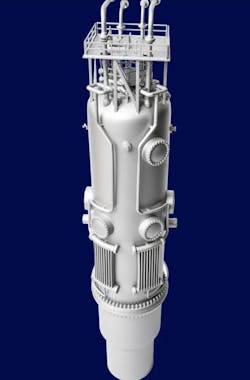SMR Rebound: NuScale Achieves New NRC Approval, University Collaborations on Nuclear Training
Small modular reactor designer NuScale Power, which has overcome some tough economic news in past years only to find its latest SMR design approved by federal regulators days ago, is also expanding its research and engineering reach within U.S. colleges and universities.
NuScale Power recently opened its latest Energy Exploration (E2) Center on the George Mason University campus in Arlington, Virginia. The E2 Center features a simulator replicating a NuScale SMR control room, allowing George Mason students to practice as control room operators for nuclear facilities of the future.
The opening of the latest NuScale E2 Center follows a series of positive moves for the SMR industry as a whole. Those steps forward include last month’s U.S. Nuclear Regulatory Commission approval of NuScale’s 77-MW US460 SMR reactor design, partially based on the company’s US600 approved two years ago by the NRC.
The NRC also has recently agreed to review construction permits for SMR projects involving Dow and X-energy, as well as a separate application by the Tennessee Valley Authority. Nuclear energy offers baseload, high-capacity factor and carbon-free power as the nation’s looks to meet a future challenge of exponential data center and electrification load growth.
Virginia is home to several conventional nuclear power plants. It’s also holds more data centers per area than any state in the U.S.
"A reliable and increasingly clean energy future is what the Virginia Clean Energy Innovation Bank is all about," said Glenn Davis, director of the Virginia Department of Energy, in a statement. "With this investment alongside world-class higher-education partners at George Mason and cutting-edge industry leaders at NuScale, we're ensuring Virginia has the energy to power our thriving economy and the expertise to continue leading the nation in innovation, education, and opportunity."
With the opening of the George Mason E2 Center, NuScale now has E2 facilities at 11 schools or research sites worldwide. The others are at Idaho State University, Ohio State, Oregon State, Rensselaer Polytechnic Institute, Texas A&M, Nevada-Los Vegas, South Carolina State, University Politehnica of Bucharest, Ghana Atomic Energy Commission and Seoul National University in South Korea.
“The opening of NuScale’s E2 Center at George Mason reinforces our mission to drive innovation in nuclear energy and inspire the next generation of leaders,” said John Hopkins, NuScale President and CEO. “Together, we are shaping a skilled nuclear-ready workforce and fostering a more informed public, providing a strong foundation for the future of clean, reliable energy in Virginia and around the world.”
The NRC approval for NuScale’s 77-MW US 460 is only a preliminary safety approval. SMR developers would still have to seek construction permit approvals to move forward with physical projects.
“The US460 design continues to use natural 'passive' processes such as convection and gravity in its operating systems and safety features,” reads the NRC official release about the design approval. “The US460’s six modules, producing a total of approximately 460 megawatts of electricity, are all partially immersed in a safety-related pool built below ground level.”
Many industrial product manufacturers and data center companies see SMR nuclear as path forward for both resilient and sustainable power in the coming decades. Tech firms which have sought SMR or conventional nuclear partnerships include Microsoft, Meta, Google, Oracle and Amazon Web Services.
NuScale Power two years ago formed a research partnership with the Oak Ridge National Laboratory on economically and technically assessing its SMRs’ ability to provide cost-effective steam heat augmentation.
The path to commercialization for NuScale’s SMR design hit a costly and potentially devastating roadblock nearly two years ago when it and partner Utah Associated Municipal Power Systems mutually agreed to terminate the so-called Carbon Free Power Project. The CFPP was going to be an SMR plant built in Idaho, pegged as the first commercially operational facility, but it was killed because not enough customers would sign on to make the multi-billion projects financially viable.
Since then, however, SMR nuclear’s momentum has revived with successful research collaborations for X-energy, Natura Resources, Aalo Atomic, Oklo and others.
In fact, the U.S. Department of Energy issued a $900 million funding solicitation for Gen III+ SMR nuclear startups. The program was a rare Biden-era initiative reissued by the Trump DOE to promote new nuclear capacity for the future.
No SMR projects have yet been built in the U.S. Work on similar reactors is moving forward in Canada, Russia and China.
About the Author
Rod Walton, EnergyTech Managing Editor
Managing Editor
For EnergyTech editorial inquiries, please contact Managing Editor Rod Walton at [email protected].
Rod Walton has spent 17 years covering the energy industry as a newspaper and trade journalist. He formerly was energy writer and business editor at the Tulsa World. Later, he spent six years covering the electricity power sector for Pennwell and Clarion Events. He joined Endeavor and EnergyTech in November 2021.
Walton earned his Bachelors degree in journalism from the University of Oklahoma. His career stops include the Moore American, Bartlesville Examiner-Enterprise, Wagoner Tribune and Tulsa World.
EnergyTech is focused on the mission critical and large-scale energy users and their sustainability and resiliency goals. These include the commercial and industrial sectors, as well as the military, universities, data centers and microgrids. The C&I sectors together account for close to 30 percent of greenhouse gas emissions in the U.S.
He was named Managing Editor for Microgrid Knowledge and EnergyTech starting July 1, 2023
Many large-scale energy users such as Fortune 500 companies, and mission-critical users such as military bases, universities, healthcare facilities, public safety and data centers, shifting their energy priorities to reach net-zero carbon goals within the coming decades. These include plans for renewable energy power purchase agreements, but also on-site resiliency projects such as microgrids, combined heat and power, rooftop solar, energy storage, digitalization and building efficiency upgrades.


